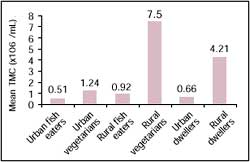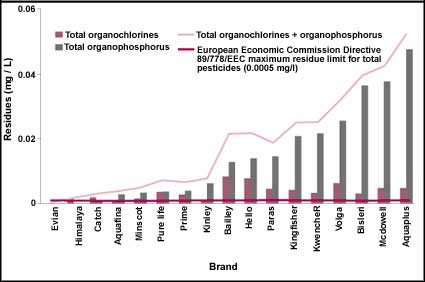|
|
|

PCB’s incriminated
Increasing evidence now incriminates polychlorinated biphenyls
(PCBs) and phthalate esters (PEs) as potential environmental hazards, which lead to the
deterioration in semen quality. Roya Rozatti and colleagues at the Assisted Conception
Services Unit of Mahavir Hospital and Research Center,
Semen
quality in different
categories of infertile men |
 |
| Source: R Rozati et
al 2002, Role of environmental estrogens in the deterioration of male factor fertility, in
Fertility and Sterility, Vol 78, No 6, December, pp 1187-1194, published by Elsevier
Science Inc., USA. |
Hyderabad, studied 557 infertile couple and the total
motile sperm count (TMC) in men was taken as a measure of semen quality. To really assess
the role of PCBs and PEs in the deterioration of male factor infertility, men where
subcategorised into: urban fish eaters, rural fish eaters, urban vegetarians and rural
vegetarians. This subcategorisation was also based on the documented sources of
xenoestrogens — domestic and industrial effluents, solid waste disposal sites, and
agricultural or urban runoff. The study excluded other factors like occupational exposure
to reproductive toxicants, history of systemic diseases or history of tobacco and alcohol
consumption and also those who had evidence of previous conception and normal semen
analyses. Control group comprised of fertile urban and rural men with no mixed diet and no
reported consumption of fish.
The highest concentration of PCBs and PEs was found in
infertile urban fish eaters, followed by infertile rural fish eaters. Amongst the
infertile, TMC was found to be lowest in the urban fish eaters, followed by the urban
dwellers. The authors reason that the rapid industralisation of Andhra Pradesh and
improper disposal of industrial effluents may account for the presence of higher
xenoestrogen concentrations and concomitantly lower TMCs in urban dwellers when compared
with rural dwellers. Andhra Pradesh today is scattered with major industries such as
cement, pharmaceuticals, petrochemicals, plastic, heavy electricals, fertilisers, tobacco
and coal.
PRODUCT
WATCH |
Bottled poison
Packaged drinking water or natural mineral water are
everywhere. They are available in pouches, cups, bottles and bulky transparent jars. They
are sipped in clubs, malls and fitness centres; glugged after a walk, jog or trek; hunted
for in railway stations and bus termini, or hurled in a traffic jam. People pick bottled
waters from paan-shops, vendor stalls, department stores and supermarkets. Office
architecture includes them, and ice-cream parlours, cafes, restaurants and hotels and
cinemas always keep a stock.
The Pollution Monitoring Laboratory (PML) of the New Delhi
— based non governmental organisation, Centre for Science and Environment (CSE),
analysed 17 different brands of packaged drinking water (PDW) and packaged natural mineral
water (PNMW) commonly sold in areas that fall within the national capital region of Delhi.
34 bottles of PDW/PNMW were tested for two kinds of pesticides: organochlorine and
organophosphorus pesticides.
No
prizes for poison Pesticide profile for different Delhi-based brands |
 |
The pml tested the 34 samples with a widely and
internationally used methodology, approved by the United States Environment Protection
Agency (usepa) for pesticide detection in drinking water.
Pesticide residues were found in all the samples, except
the imported Evian. The pesticides residues found were of the deadliest kind. Among
organochlorines, gamma-Hexachlorocyclohexane (g-hch, or lindane) and ddt were the most
prevalent. Among organophosphorus pesticides, Malathion and Chlorpyrifos were most common.
Pesticides possess chronic health effects, effects that
occur long after repeated exposure to miniscule amounts of these toxic chemicals.
Slow, almost invisible, contamination leads to cancer,
liver and kidney damage, disorders of the nervous system, damage to the immune system and
birth defects. Such are the dangers that pesticide residues in marketed bottled water are
opening the trusting consumer up to. This is called low dose chronic exposure. Pesticides
persist in the environment and slowly, through the food and
water, enter human bodies and accumulate in body fat.
Adding to the knowledge on the carcinogenic effects of pesticides are recent scientific
studies, from within a field of study called immunotoxicology, that point to the impact on
the immune system. It is now evident that pesticides in human bodies have an
immunosuppressive effect — reduced immunity obviously exacerbates diseases like
cancer or asthma.
See full report at: www.cseindia.org/html/lab/bottled_water_result.htm |
Water for health
With an estimated 3.4 billion deaths taking place each year
due to inadequate water and sanitation, the United Nations Committee on Economic, Cultural
and Social Rights has now formally declared safe and secure drinking water as a human
right. According to Gro Harlem Brundtland, director-general, World Health Organisation,
"Countries will be required to ‘respect, protect and fulfil’
individuals’ rights to safe drinking water and sanitation." This would help
achieve the Millennium Development Goals of halving the number of people without access to
water and sanitation by 2015. One in every six individuals does not have access to clean
drinking water and one in every 2.5 individuals still do not have access to safe latrine.
The right to water goal includes the right to maintain access to existing water supplies
necessary; and the right to be free from interference, such as the right to be free from
arbitrary disconnections or contamination of water supplies. |
| |
|